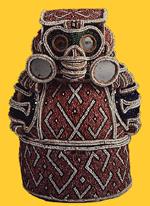Religion
The Taino culture believed the world and everything in it was alive with supernatural power, including features of the landscape - mountains, caves, rivers, trees, and the sea - as well as the souls of animals and people. The earth was a thin layer between heaven and hell.
There were three primary religious practices:
- Religious worship and obeisance to the zemi themselves.
- Dancing in the village court during special festivals of thanksgiving or petition.
- Medicine men, or priests, consulting the zemi for advice and healing. This was done in public ceremonies with song and dance.
One account of the religious agricultural feasts which were offered both in thanksgiving and petition, describes the following features:
- People had special dress for the ceremonies which included paint and feathers. From their knees on down they would be covered in shells.
- The shaman (medicine man or priests) presented the carved figures of the zemi.
- The cacique sat on wooden stool, a place of honor. (There are many surviving stone carvings of the cacique on his stool.)
- There was a ceremonial beating of drums.
- People induced vomiting with a swallowing stick. This was to purge the body of impurities, both a literal physical purging and a symbolic spiritual purging.
- This ceremonial purging and other rites were a symbolic changing before zemi.
- Women served bread (a communion rite), first to zemi, then to the cacique followed by the other people. The sacred bread was a powerful protector.
- Finally came an oral history lesson -- the singing of the village epic in honor of the cacique and his ancestors. As the poet recited he was accompanied by a maraca, a piece of hardwood which was beaten with pebbles.
Zemi
 | The zemi controlled various functions of the universe, very much like gods did. In alot of ways he was like the Yocahu just in a different form.
|
Cemis
 | Cemís represents the spirit of the god Yocahú. The cemís were kept in shrine rooms. Taínos believed cemís had powers that affected weather, crops, health, and childbirth, among other things. Most of the representations of cemis were of animials and men with frog-like legs. |